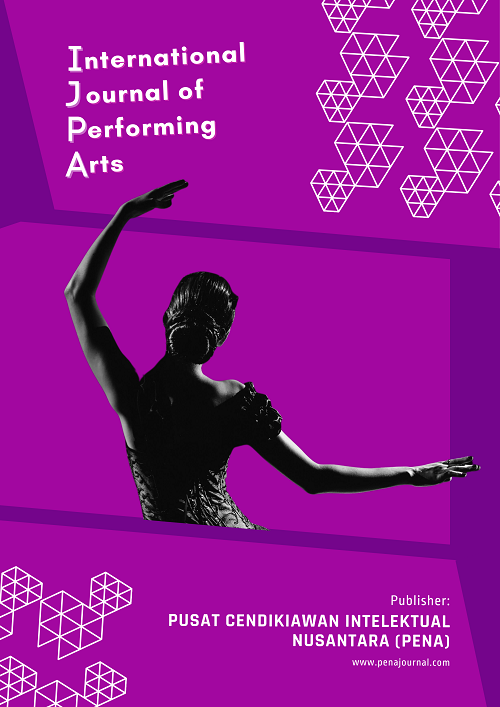THE CONSTRUCTION OF NANDAK ZABET TAK-TUNG DANCE: ADAPTATION OF ZAPIN AND SAMRAH MOVEMENTS WITHIN THE ARABMALAY PERANAKAN CULTURAL CONTEXT
THE CONSTRUCTION OF NANDAK ZABET TAK-TUNG DANCE: ADAPTATION OF ZAPIN AND SAMRAH MOVEMENTS WITHIN THE ARABMALAY PERANAKAN CULTURAL CONTEXT
DOI:
https://doi.org/10.56107/ijpa.v4i1.252Abstract
This study analyzes dance as a medium of cultural acculturation through the creation of Nandak
Zabet Tak-Tung, rooted in the Betawi cultural framework. It focuses on adapting Zapin and Samrah
movements to represent Arab-Malay Peranakan heritage, while exploring interdisciplinary
connections with music, scenography, and other artistic elements. The research employs a qualitative
method with systematic stages: defining focus, collecting data via direct observation, in-depth
interviews, and document analysis. Data are organized into a structured matrix to support
interpretation.
The theoretical foundation draws from Alma M. Hawkins’ creative concept in Moving from Within,
translated by I Wayan Dibia, encompassing six aspects: experiencing, seeing, feeling, imagining,
transforming, and forming. These guide the choreographic process, resulting in a work that
reconfigures Zapin and Samrah into a dynamic structure emphasizing movement exploration and
embodiment.
Through imaginative choreography inspired by local traditions, the study proposes the use of ArabMalay Peranakan-based movement to enrich Betawi dance. It contributes to the preservation and
innovation of Indonesian performing arts by integrating cultural heritage with contemporary
expression. Ultimately, this research supports the advancement of knowledge, technology, and sociocultural development within a humanistic and locally grounded artistic landscape.
References
Alma M Hawkins, I. W. D. (2003). Moving From Within: A New Method for Dance Making
(Terjemahan: Bergerak menurut Kata Hati: Metoda Baru dalam Menciptakan Tari) (I Wayan
Dibia (ed.); Pertama). Ford Foundation dan Masyarakat Seni Pertunjukan Indonesia.
Jufri, A. (2009). Migrasi Orang Arab Hadramaut Ke Batavia Akhir Abad XVIII Awal Abad XIX.
Parani, J. (2006). Intercultural Jakarta, ambiance of Batawi theatre to Indonesian theatre. Wacana
Seni : Journal of Arts Discourse, 5, 44–68.
Parani, J. dkk. (2017). Bunga Rampai: Seni Pertunjukan Kebetawian (G. R. S. A. Bondowoso (ed.);
Pertama, 2, p. 583). IKJ Press.
Rasi, A. (1999). Asimilasi, Akulturasi, dan Integrasi Nasional. 1928, 29–37.
Shahab, H., Faluti, M. Z., & Soemarni, L. L. (2024). Peran Kesenian Samrah Betawi Dalam
Pendidikan Dan Pengembangan Karakter. Jurnal Sains Terapan Pariwisata, 9(3), 174–183.
https://doi.org/10.56743/jstp.v9i3.434
Soewardjo, B. K. (2022). Pengembangan Perempuan dalam Budaya Peranakan melalui Penciptaan
Karya Tari Cokek Berjudul Nyai Cukin Era Jakarta Tempo Doeloe. Jurnal Pendidikan Tari,
(2), 25–51. https://doi.org/10.21009/jpt.223
Soewardjo, B. K., Supriadi, D., Rakhman, R. T., & Prayitno, E. H. (2024). Embodiment of
Symbolism and Meaning of Human Life Phases in the Characteristics of Topeng Tunggal
Through the Creation of a Dance Film Titled Nindak Jirumklan. KnE Social Sciences, 2024, 8–
https://doi.org/10.18502/kss.v9i9.15644
Sofyan, A. N. (2024). Regenerasi Seni Samrah Khas Betawi Wilayah Utara Bekasi Provinsi Jawa
Barat. Jurnal Kajian Budaya Dan Humaniora, 6(3), 242–250.
https://doi.org/10.61296/jkbh.v6i3.275
Tjetjep Rohendi Rohidi. (2011). Metode Penelitian Seni (T. R. Rohidi (ed.); 10987654 2).
https://doi.org/978-602-8054-40--9
Wahyu Mukti, M. P., Wadiyo, W., & Supriyanto, T. (2024). Challenges and Transformation:
Revealing the Dynamics of Socio-Cultural Change in the Modern Era. Jurnal Pakarena, 9(1),





















